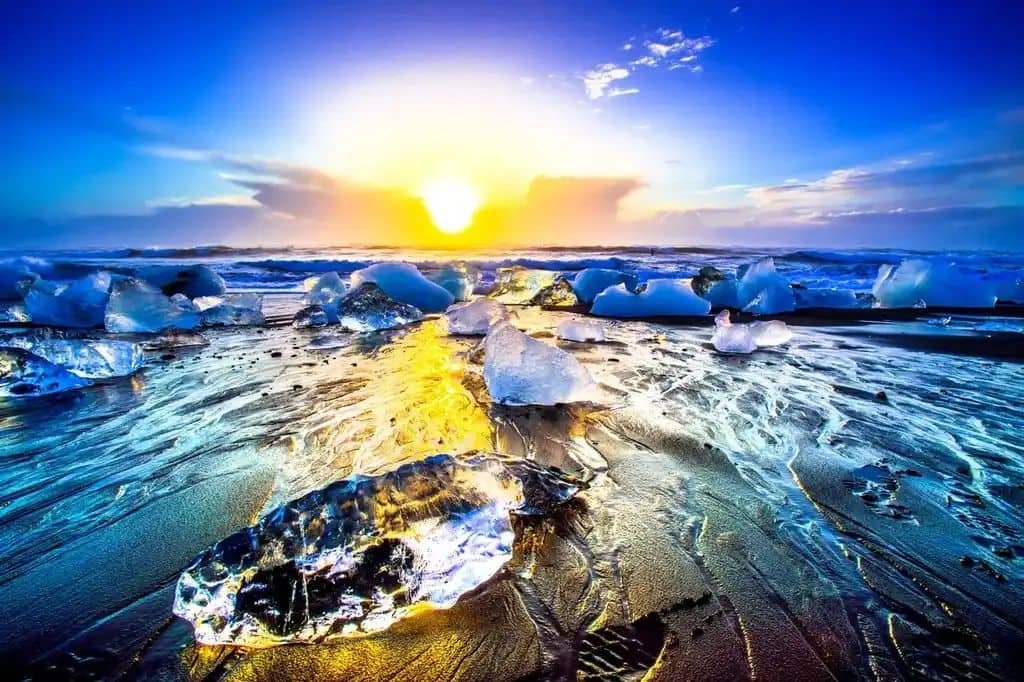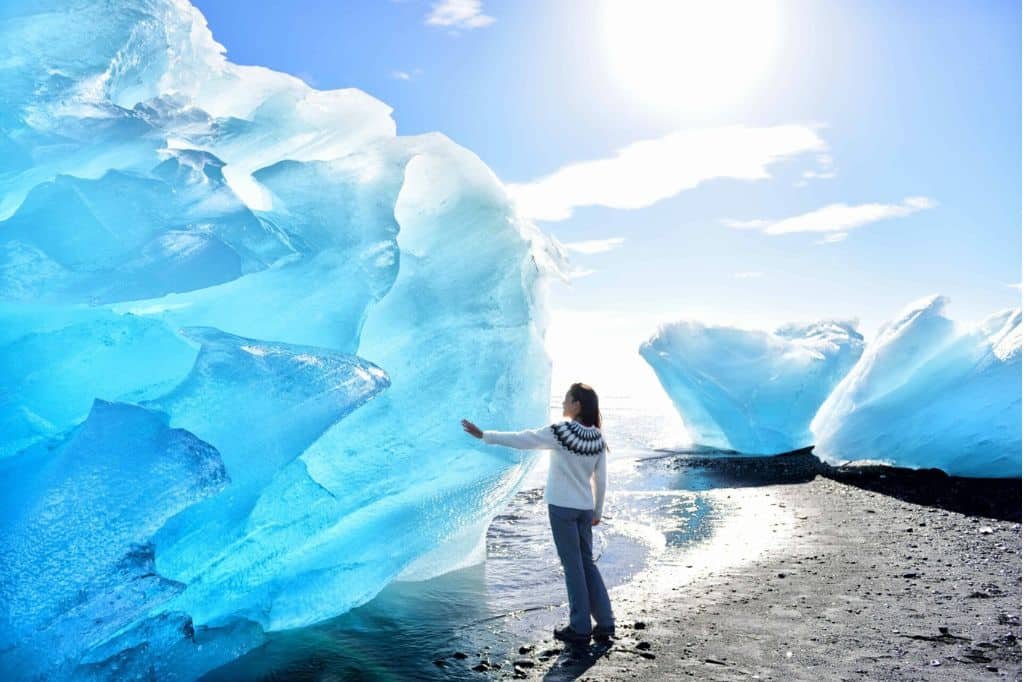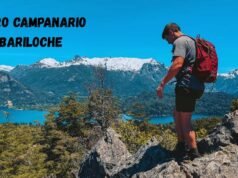Diamond Beach Iceland is one of the country’s most mesmerizing natural wonders, located along the stunning south coast. It’s a stretch of jet-black volcanic sand scattered with glistening chunks of ice, making it look like a beach adorned with shimmering diamonds. This surreal setting draws travelers, photographers, and nature lovers from all over the world.
What makes Diamond Beach, Iceland, truly unique is the constant arrival of icebergs that break off from the nearby Breiðamerkurjökull Glacier and float through the Jökulsárlón Glacier Lagoon before washing up on shore. The stark contrast between the crystal-clear ice and dark sand creates a dramatic, otherworldly landscape that changes with every tide.
What Is Diamond Beach Iceland?
Diamond Beach, Iceland, is not your typical sandy shoreline—it’s a dynamic natural gallery sculpted by Iceland’s powerful glaciers and volcanic forces. The beach gets its name from the icebergs that rest on the black sand like scattered gemstones, their jagged edges sparkling in the sunlight.
The ice that washes ashore comes from Breiðamerkurjökull, an outlet glacier of Vatnajökull, the largest ice cap in Europe. As these ice chunks break off and drift through the Jökulsárlón Lagoon, they eventually make their way to the Atlantic Ocean and are pushed back onto the beach by the waves. This ongoing process gives Diamond Beach its ever-changing appearance and magical charm.
Related Read: Vik Iceland
Where Is Diamond Beach Located?
Diamond Beach is located on Iceland’s southern coast, just off the famous Route 1 (the Ring Road), about 370 km (230 miles) east of Reykjavík. It lies directly opposite the Jökulsárlón Glacier Lagoon—connected by a short bridge that separates the lagoon from the Atlantic Ocean.
The beach is part of the larger Vatnajökull National Park area, offering breathtaking views of glaciers, ice formations, and dramatic coastal scenery. Visitors can easily access the beach by car or join one of the many south coast tours that include stops at both Diamond Beach and Jökulsárlón.
GPS Coordinates: 64.0445° N, 16.1784° W
Google Maps: Simply search for “Diamond Beach Iceland” and follow Route 1 until you reach the bridge near the lagoon.
How to Get to Diamond Beach?
Driving from Reykjavík:
Diamond Beach is approximately a 5–6 hour drive from Reykjavík along Iceland’s Ring Road (Route 1). Head east on Route 1, passing through scenic towns like Vik and Höfn. The beach is just off the highway, near the Jökulsárlón Glacier Lagoon. Parking is available on both sides of the bridge that connects the lagoon to the ocean.
Guided Tours – Pros & Cons:
Many travelers opt for guided day or multi-day tours from Reykjavík or Vik. These tours typically include other highlights like waterfalls, glaciers, and the lagoon.
Pros: No driving stress, expert guides, and safety during winter.
Cons: Limited time at each stop, higher cost, less flexibility.
Travel Tips by Season:
- Winter: Be prepared for icy roads and limited daylight. Rent a 4WD vehicle, check road conditions, and avoid driving in storms.
- Summer: Roads are clear, and daylight lasts nearly 24 hours. Great for flexible travel and sightseeing stops.
Read More: Iceland Northern Lights
What Makes Diamond Beach Unique?

Diamond Beach’s uniqueness lies in its stunning natural contrasts. The beach is covered in fine black volcanic sand, a result of Iceland’s volcanic activity. Against this dark backdrop, glacial icebergs—some as large as cars, others small and crystalline—glitter like diamonds as they are washed ashore by the Atlantic waves.
These ice chunks originate from Breiðamerkurjökull, a glacial tongue of the massive Vatnajökull glacier. They break off into Jökulsárlón Lagoon, float serenely in the water, and are eventually pulled out to sea. Some of them are then swept back onto the beach, creating a constantly shifting and mesmerizing display.
No two visits are the same. The tide, light, and weather all influence the appearance of the beach. One moment, you might see clear, glass-like ice reflecting the sky, and the next, deep blue chunks embedded with volcanic ash, all sparkling against the dark sand. This constant transformation is part of what makes Diamond Beach so captivating.
Best Time to Visit Diamond Beach
Diamond Beach is beautiful year-round, but each season offers a different experience.
- Summer (June–August): Easier driving conditions, smaller ice chunks, longer days, and milder weather. Ideal for comfortable exploration and photography under the midnight sun.
- Winter (November–March): Larger, more dramatic icebergs and a chance to see the northern lights. However, expect cold temperatures, snow, and short daylight hours.
Photography Tips:
For the best photos, visit during golden hour—just after sunrise or before sunset. Early mornings often have fewer visitors, while late evening light makes the ice glow dramatically.
Weather Considerations:
Check forecasts via vedur. is. Be mindful of wind, especially in winter, as conditions can change rapidly.
Read Also: Arctic Adventures Iceland
What to Expect at Diamond Beach
Diamond Beach offers a surreal landscape of glittering icebergs resting on black volcanic sand. As tides roll in and out, the ice constantly shifts, meaning no two visits are ever the same. Visitors often describe the scene as otherworldly, especially when the sunlight catches the crystal-clear ice.
Wildlife Spotting:
Keep an eye out for seals lounging on icebergs or swimming near the shore. Seabirds, especially arctic terns and skuas, are common in the area during warmer months.
Crowd Levels:
The beach can get busy in summer, especially midday when tour buses arrive. For a quieter experience, visit early in the morning or later in the evening. Winter tends to have fewer crowds, but weather can be a limiting factor.
Diamond Beach Photography Tips

Diamond Beach is a dream location for photographers. To make the most of your shots, explore both sides of the bridge to find icebergs of varying size and clarity. Close-up shots of ice with ocean waves in the background often create the most striking images. Wide-angle shots showcasing the contrast between black sand and crystal-clear ice also work beautifully.
Lighting & Time of Day:
The best lighting is during golden hour—just after sunrise and before sunset. In summer, this can stretch for hours. In winter, limited daylight makes timing more critical, but soft light enhances the dramatic look of the ice.
Recommended Gear & Safety:
Bring a DSLR or mirrorless camera with a wide-angle lens for landscapes and a macro lens for detailed ice shots. Use a tripod for long exposures, especially in low light. Waterproof boots and gloves are essential, as you may need to crouch near the shoreline. Stay alert—waves are strong and can unexpectedly sweep ice toward you.
To Know More: Things to Do in Jeju Island
Nearby Attractions
Your visit to Diamond Beach pairs perfectly with several nearby natural wonders:
- Jökulsárlón Glacier Lagoon: Just across the road, this lagoon is filled with floating icebergs from the Breiðamerkurjökull glacier. You can take a boat tour in summer or simply admire the ice from the shore.
- Fjallsárlón Ice Lagoon: A quieter, less-visited cousin of Jökulsárlón, about 10 km west. Offers stunning views and photo ops with fewer crowds.
- Vatnajökull National Park: Home to Europe’s largest glacier. Great for ice cave tours (winter), glacier hikes, and photography of rugged Icelandic landscapes.
- Skaftafell Nature Reserve: Located about an hour west, Skaftafell offers excellent hiking, including trails to waterfalls like Svartifoss and panoramic glacier views.
Safety Tips and Practical Info
Diamond Beach is both beautiful and wild, so preparation is key for a safe visit.
Dress Smart:
Layer up with windproof and waterproof outerwear. Even in summer, it can be cold and windy. Waterproof hiking boots and gloves are highly recommended, especially for exploring icy or wet areas.
Stay Safe:
Do not climb on icebergs—they can shift or collapse without warning. Be cautious of “sneaker waves” that can sweep across the beach unexpectedly and pull objects (or people) into the ocean.
Facilities:
There’s a parking lot near the bridge with access to both Diamond Beach and Jökulsárlón. Basic restroom facilities are available at the lagoon side.
Food & Fuel:
There’s a small café near the lagoon with snacks and hot drinks. The closest fuel stations and restaurants are in Höfn or Vik, so plan accordingly.
Read: Cannon Beach Oregon
Conservation and Visitor Responsibility
Diamond Beach is not only a stunning natural attraction but also a fragile ecosystem that demands respect and care from its visitors. As tourism in Iceland continues to grow, so does the importance of preserving the natural beauty that draws people here in the first place.
The beach and the surrounding glacial environment are highly sensitive to human impact. Icebergs, while temporary and ever-changing, are still part of a delicate glacial system. Visitors should avoid climbing on or moving the ice, as this can be dangerous and disruptive to the natural setting. Additionally, littering not only mars the landscape but can also threaten the wildlife that inhabits the area.
Practicing responsible tourism at Diamond Beach includes:
- Staying on marked paths and not trampling delicate plant life near the beach.
- Carrying out all trash, including biodegradable items.
- Keeping a respectful distance from wildlife, particularly seals and nesting birds.
- Supporting eco-conscious tour operators who prioritize sustainability and education.
By being mindful of our actions, we ensure that this unique environment can be enjoyed by future generations.
Frequently Asked Questions (FAQs)
Is Diamond Beach free to visit?
Yes, Diamond Beach is completely free to visit. There are no entrance fees, and parking near the beach and Jökulsárlón Lagoon is also free.
Are you allowed to walk on the ice?
While you can walk up close to the icebergs on the beach, it is not recommended to climb on them. Icebergs can be slippery and unstable, posing a serious safety risk due to sudden shifts or melting.
How were the icebergs formed?
The icebergs originate from the Breiðamerkurjökull glacier, which calves into Jökulsárlón Glacier Lagoon. These chunks of glacial ice float through the lagoon into the Atlantic Ocean and wash back onto Diamond Beach with the tides.
Is it open all year round?
Yes, Diamond Beach is accessible year-round. However, weather and road conditions in winter can affect travel plans, so it’s important to check forecasts and road updates before setting out.
Are there guided tours or packages?
Yes, many South Coast and multi-day Iceland tours include stops at both Diamond Beach and Jökulsárlón Lagoon. These can be booked from Reykjavík or other towns and are especially popular during winter for northern lights sightings.
Conclusion
Diamond Beach Iceland is one of the country’s most visually stunning and unforgettable natural attractions. The dazzling mix of black volcanic sand and luminous ice fragments creates a scene that feels straight out of a dream. Combined with the nearby Jökulsárlón Glacier Lagoon, it offers a once-in-a-lifetime opportunity to witness nature’s raw beauty and power up close.
To make the most of your visit, plan for unpredictable weather, dress in warm, waterproof layers, and explore both sides of the bridge connecting the lagoon to the sea. Whether you go in summer beneath the midnight sun or in winter under the glow of the northern lights, Diamond Beach Iceland is a must-visit stop on any South Coast Iceland itinerary.
















[…] Related: Diamond Beach, Iceland […]
Comments are closed.